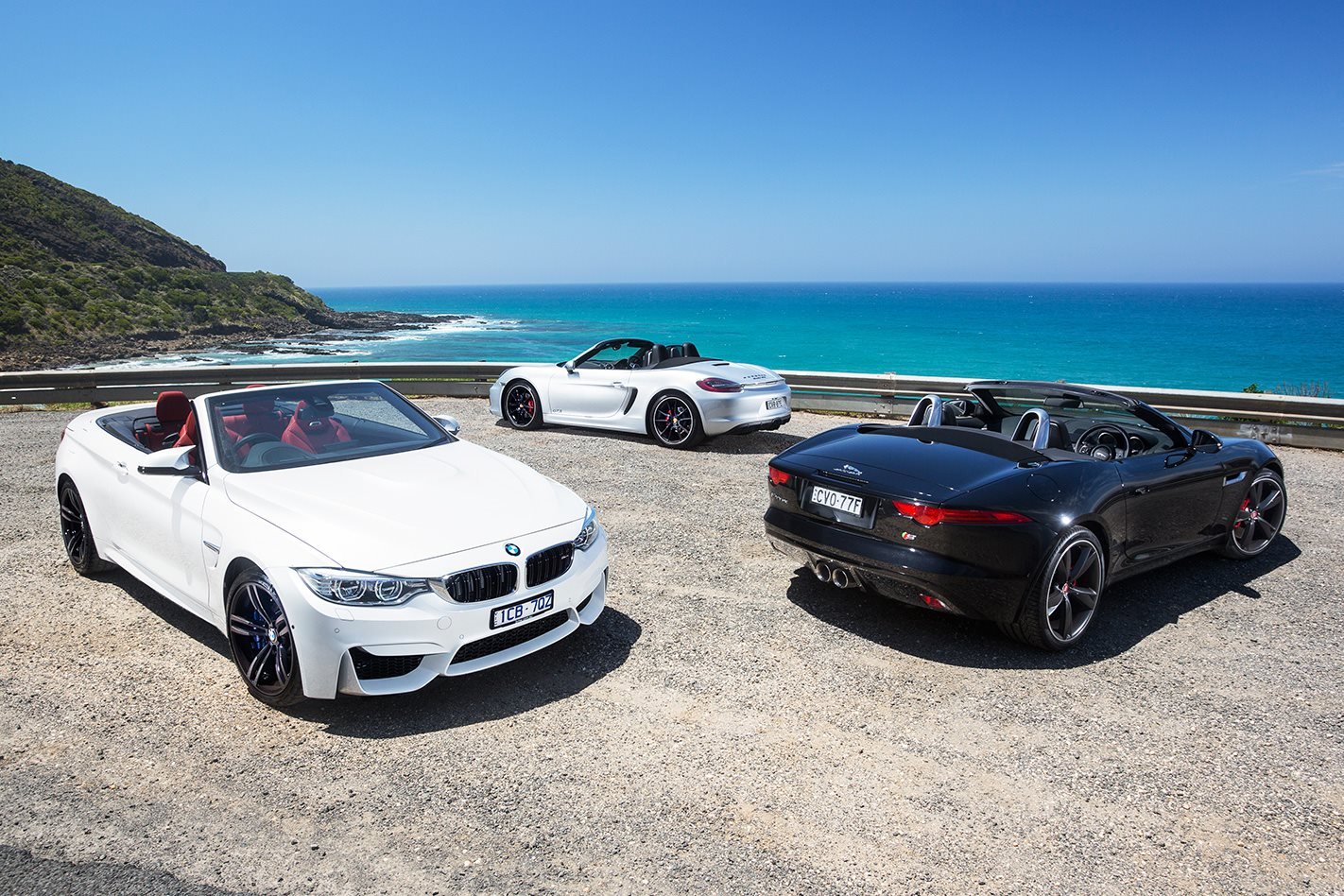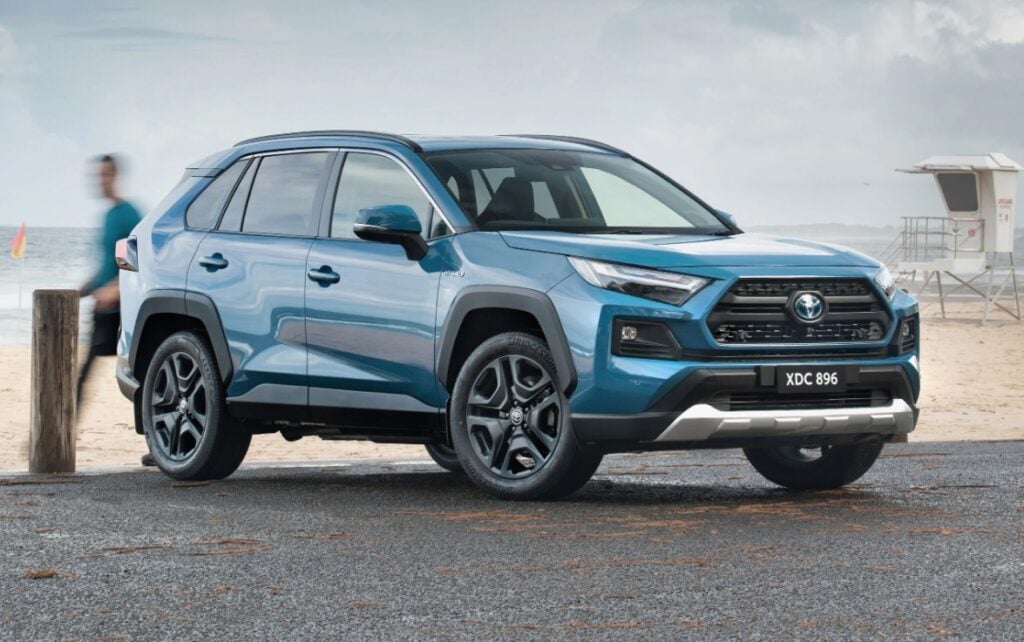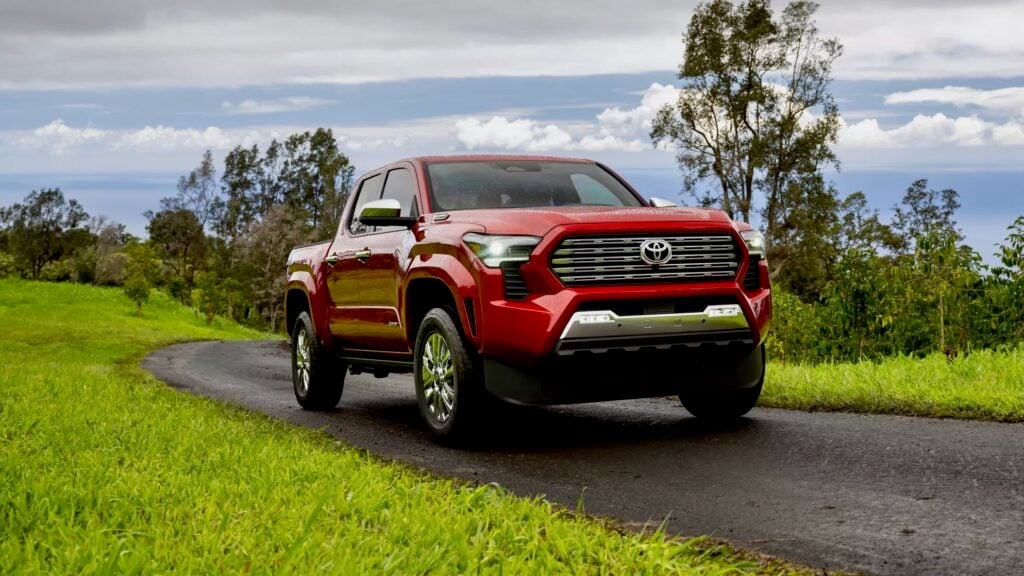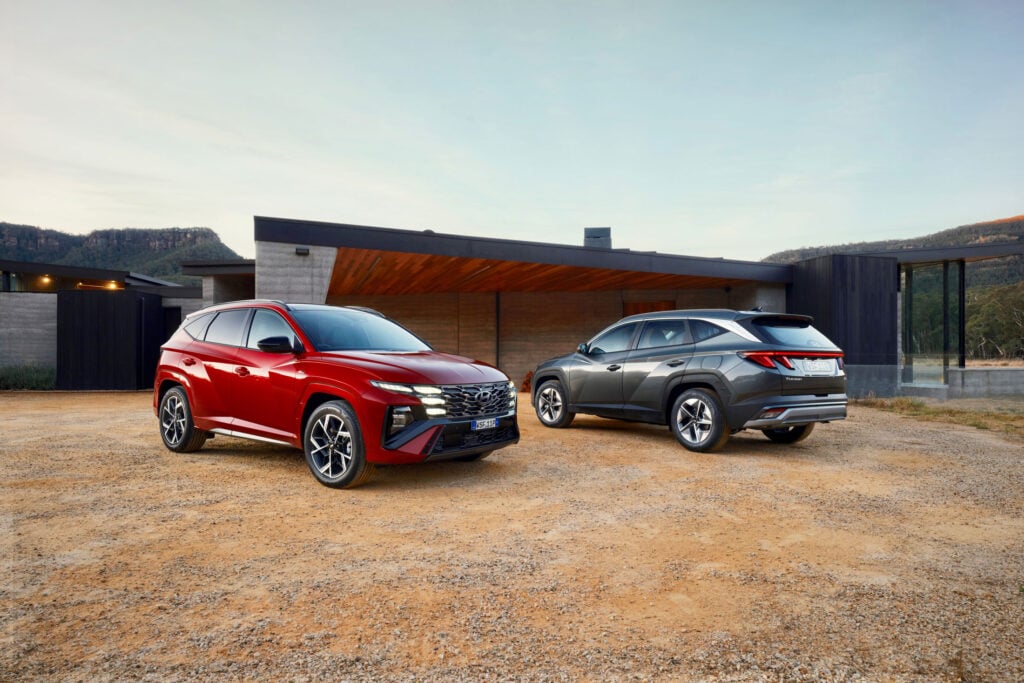Once upon a time, the only real sports cars were convertibles.
Sure, there were sporty cars with roofs, but if you wanted a proper driving experience, you needed the wind in your hair and the sun on your face. The flies in your eyes and grit in your teeth weren’t mentioned so much, but let’s not spoil the romance. Cruising along a winding road in an Austin-Healey 3000 or Alfa Giulietta Spider – driving nirvana.
At some point, however, possibly around the muscle car era of the late 60s or early 70s, it all went awry. Open-top cars became wobble-bodied pose machines, built for the Cote d’Azur rather than the Col de Turini; more Sunset Boulevard than Spa-Francorchamps. They remain hot property, though, so with another Aussie summer upon us we felt it was time to discover what today’s drop-tops bring to the table.
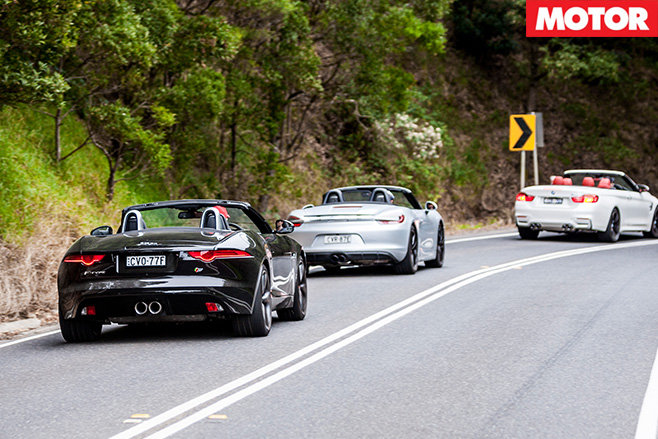
Losing the roof adds $12,000 to the price ($178,430), while the complex folding hardtop and requisite body strengthening add a hefty 253kg to the kerb weight. The F32 is, however, 60kg lighter than its predecessor and, in dual-clutch form, cheaper too.
Its closest challenger, on paper at least, is Jaguar’s F-Type V6 S. Priced at $170,575, the V6 S also packs a 3.0-litre force-fed six-cylinder, albeit in vee configuration and boosted by a supercharger rather than a pair of turbos, delivering 280kW and 460Nm. This is our first proper exposure to a six-pot F-Type – can it match the thrills offered by its V8-engined siblings?
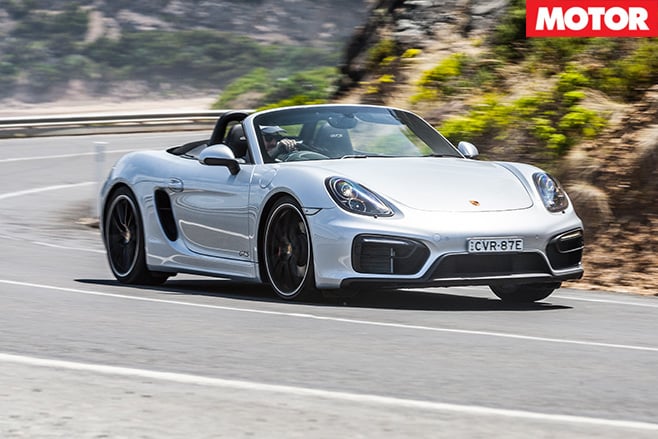
The GTS treatment also brings a slight lift in output to 243kW and 370Nm. Even fitted with the seven-speed PDK ’box, though, it’s easily our cheapest contender at $151,790.
The packaging advantages offered by its mid-engined layout also make it by far the smallest car here. Each successive Boxster has been more aggressive than the last, but it’s still more feminine than its brawny, traditional front-engine, rear-drive rivals. It’s a good-looking thing, even if the black highlights of the GTS make it look a bit like it’s going through a teenage ‘emo’ phase.
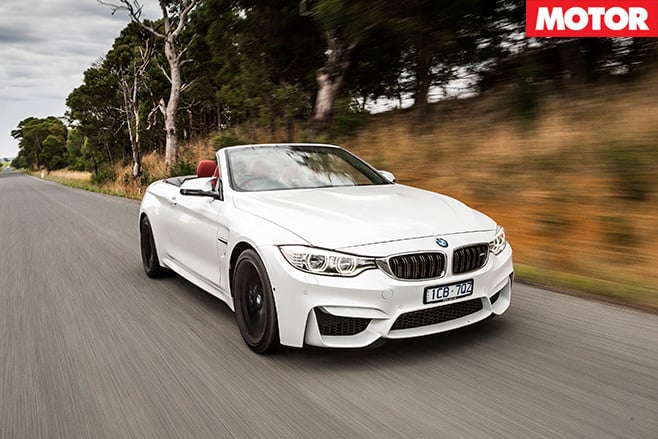
It certainly doesn’t lack aggression; M cars of old were subtle to the point of anonymity (which isn’t without its virtues) but there’s no doubting the M4’s intent. Following it in the Boxster, its narrow glasshouse and Kardashian hips give the impression that it’s swallowed a lesser 4-Series whole.
When it comes to the catwalk, though, appropriately it’s the Jaguar that steals the show. Wherever it pulls up passers-by point and produce camera phones. You could argue that it’s not quite as good-looking as its hardtop twin, but that’s like debating who’s the better looker out of Miranda Kerr and Mila Kunis.
Its case is further enhanced by green and red flecks in the black paint that sparkle in direct sunlight and those carbon-bladed 20s, which look so good $6800 suddenly doesn’t seem so steep.

At the strip it reels off 4.98sec to 100km/h and a 13.16sec quarter mile at 175.79km/h. It’s a breeze to launch: load it briefly against the brake and floor the throttle. There’s next to no wheelspin and the quick-shifting, close-ratio eight-speed ZF auto makes the most of the available power, while also proving that even the best dual-clutch gearboxes are yet to match the low-speed smoothness of a good automatic.

What could have gone faster is the Boxster. Its 5.11sec 0-100km/h and 13.29sec quarter mile times (at 173.77km/h) were well down on the 4.49sec and 12.66sec recorded in the (almost) mechanically identical Cayman GTS at PCOTY last year.
Blame the surface. On Heathcote’s slippery start line, launch control simply blazed the rear tyres and any other technique was still slower than letting the electronics do it. In one way the numbers are representative, though, as the Boxster feels a little slower than the Jag.

Allowing emissions regulations to kill this engine in favour of a 2.0-litre turbo four should be a crime against the Geneva Conventions, particularly since this ‘high-polluting’ atmo engine averaged a parsimonious 10.2L/100km, compared to 12.0L/100km for the Jaguar and 12.1L/100km for the BMW. Forced induction might shine on the highly controlled (and highly misleading) official consumption test, but in the real world the evidence doesn’t match the manufacturer’s claims.

It certainly shows up the BMW’s DCT. Once on the move it’s superbly responsive with lightning-quick shifts, but the engineered-in thump during full-throttle upchanges is irritating (and can break traction on slippery surfaces) and its low-speed behaviour is often clumsy. Simply performing a smooth three-point turn can take an age.
When it comes to speed, however, the M4 is in a class of its own. Despite being the biggest and heaviest (1750kg) car here, its greater power and excellent launch control system delivered 0-100km/h in 4.46sec and a 12.61sec quarter mile at 184.74km/h. M4 first, daylight second. The figures are no surprise from behind the wheel, as the BMW feels appreciably the fastest of the trio.
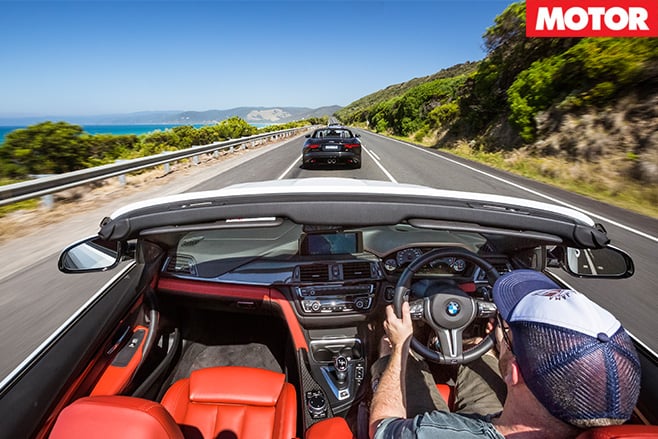
Sadly, one area the new engine is no match for its predecessor is noise, though it is at its best in the Convertible. While it never approaches the heaven-sent soundtrack of the old bent-eight, with the roof down you are privy to all sorts of growls, snorts and bangs that remain unheard in the hardtop. It turns out the new M4 sounds pretty good. You just usually can’t hear it.

In the dry, traction is incredibly strong, though when it does run out you have to act quickly to catch the ensuing slide. Back-to-back with the Coupe you’d no doubt feel the extra weight of the drop-top, but in isolation it’s still more than capable of tearing any given road apart. Keep that roof up when you’re having a punt, though, as there’s an alarming degree of body wobble over bumps in al fresco mode.

Unlike the Germans, you’re unable to separate chassis and engine settings, so the Jag is either ‘Dynamic’ or not. Being able to select Dynamic for the powertrain while retaining the softer chassis setup would be beneficial, as the F-Type can skip over bumps in its stiffer setting.
In fact, the ride is pretty firm regardless. The front end also doesn’t always provide the feedback you’d like, either, and the mechanical limited-slip diff is far too loose, the inside rear wheel easily spinning up out of corners. It feels at its best – which admittedly is very good – at about eight-tenths, but there’s no way it can match the M4’s pace.
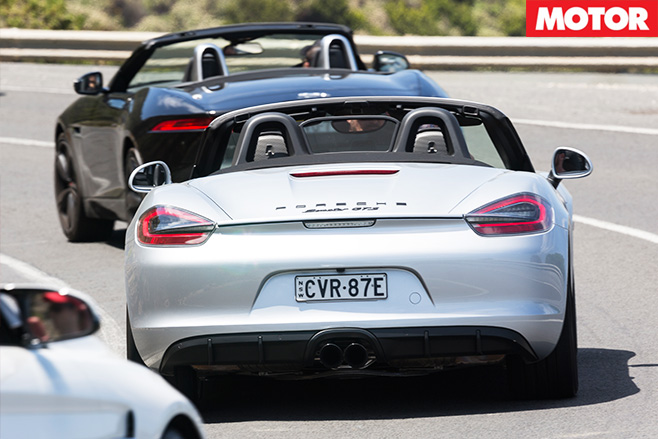
The structure feels every bit as stiff as the Cayman, the ride is sublime – by far the best here – the brakes are brilliant, the list goes on. More than its component parts, though, it’s the way the Porsche gets better and better the harder you push, rather than coming apart at the seams, that sets it apart.

Porsche isn’t alone in this game, though. Our test F-Type V6 S is $184,800, with Jaguar also asking extra for basics such as metallic paint ($2810) and parking assist ($1725), though the latter is now standard on the (more expensive) MY16 F-Type. And then there’s its practicality, or lack of it.
Forgo a space-saver spare and the boot will accommodate a couple of squishy bags, but with a spare in place there is virtually zero luggage space, meaning you either travel alone and use the passenger space for luggage or limit your F-Type experience to day trips.
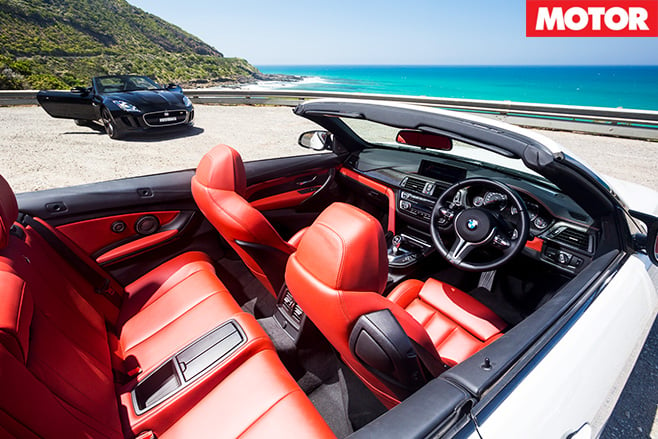
While far better to drive than most will give it credit for, it just goes against everything the M Division stands for. What’s the point of engineers slaving away for months saving every gram of weight possible only to add 250kg back on? That the BMW M4 was most enjoyable cruising around town kind of says it all.
The Jaguar does an excellent job of being the quintessential British roadster. It’s dripping with character inside and out and looks and sounds amazing. Unfortunately, while a likeable car, in pure driving terms the jiggly ride gets irritating and the handling isn’t sharp enough to compensate.

In terms of ability, however, there is a clear winner. The Boxster GTS comes incredibly close to receiving the full five stars, simply because there are so few ways in which to improve it. It’s the most comfortable car here, yet also the sharpest and most rewarding to drive.
Personally, I’d choose it over the Cayman, simply because having no roof doesn’t seem to penalise it in any way yet gives even better access to that incredible engine note.
You might no longer need to have a convertible to have a real sports car, but if you want a proper driving experience, you need a Boxster GTS.
| u00a0 | Porsche Boxster GTS | BMW M4 Convertible | Jaguar F-Type V6 S |
| Body | 2-door, 2-seat convertible | 2-door, 4-seat convertible | 2-door, 2-seat convertible |
| Drive | rear-wheel | rear-wheel | rear-wheel |
| Engine | 3436cc flat-6, DOHC, 24v | 2979cc inline-6, DOHC, 24v, twin-turbo | 2995cc V6, DOHC, 24v, supercharger |
| Bore/Stroke | 97.0 x 77.5mm | 89.6 x 84.0mm | 84.5 x 89.0mm |
| Compression | 12.5:1 | 10.2:1 | 10.5:1 |
| Power | 243kW @ 6700rpm | 317kW @ 5500-7300rpm | 280kW @ 6500rpm |
| Torque | 370Nm @ 4500-5800rpm | 550Nm @ 1850-5500rpm | 460Nm @ 3500-5000rpm |
| Power/Weight | 181kW/tonne | 181kW/tonne | 173kW/tonne |
| Consumption | 10.2L/100km (tested) | 12.1L/100km (tested) | 12.0L/100km (tested) |
| CO2 Emissions | 243g/km (tested) | 288g/km (tested) | 287/km (tested) |
| Transmission | 7-speed dual-clutch | 7-speed dual-clutch | 8-speed dual-clutch |
| Weight | 1345kg | 1750kg | 1614kg |
| Suspension | struts, A-arms, anti-roll bar (f); multi-links, coil springs, adaptive dampers, anti-roll bar (r) | struts, A-arms, adaptive dampers, anti-roll bar (f); multi-links, coil springs, adaptive dampers, anti-roll bar (r) | A-arms, coil springs, anti-roll bar (f/r) |
| L/W/H | 4404/1801/1273mm | 4671/1870/1386mm | 4470/1923/1308mm |
| Wheelbase | 2475mm | 2812mm | 2622mm |
| Tracks | 1526/1540mm (f/r) | 1579/1603mm (f/r) | 1597/1649mm (f/r) |
| Steering | electrically-assisted rack-and-pinion | electrically-assisted rack-and-pinion | hydraulically-assisted rack-and-pinion |
| Brakes | 330mm ventilated/drilled discs, 4-piston calipers (f); 299mm ventilated/drilled discs, 2-piston calipers (r) | 380mm ventilated/drilled discs, 4-piston calipers (f); 370mm ventilated/drilled discs, 2-piston calipers (r) | 380mm ventilated discs, 2-piston calipers (f); 325mm ventilated discs, single-piston calipers (r) |
| Wheels | 20 x 8.0-inch (f); 20 x 9.5-inch (r) | 19.0 x 9.0-inch (f); 19 x 10.0-inch (r) | 20.0 x 9.0-inch (f); 20 x 10.5-inch (r)u00a0 |
| Tyres | 235/35 ZR20 88Y (f); 265/35 ZR20 95Y (r) Pirelli P Zero | 255/35 ZR19 92Y (f); 275/35 ZR19 100Y (r) Michelin Pilot Super Sport | 255/35 ZR20 97Y (f); 295/30 ZR20 101Y (r) Pirelli P Zero |
| Price | $145,500 | $178,430 | $170,575 |
| Price as Tested | $167, 150* | $189,390* | $184,800* |
| Positives | Bewitching engine; superb chassis; great ride; practicality; value | Hugely fast; useability; interior quality; more theatre than hardtopu00a0 | Punchy engine; amazing noise; great styling; feel-good factor |
| Negatives | Possibly the last atmo Boxster; intergalactic gearing | Lack of roof-down rigidity; should still sound better; weight | Irritating ride; not super sharp to drive; lacks practicality |
| u00a0 | 4.5 out of 5 | 3.5 out of 5 | 3.5 out of 5 |


